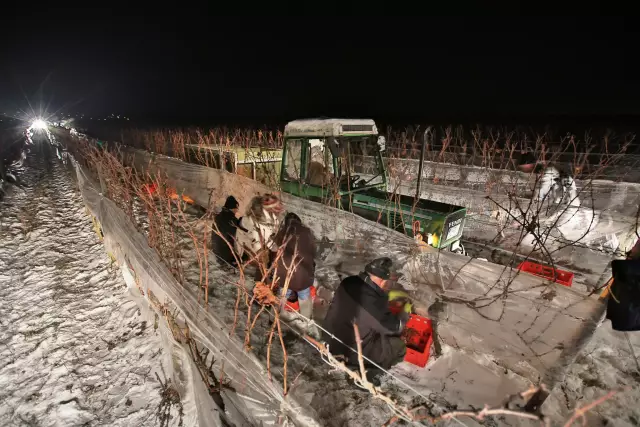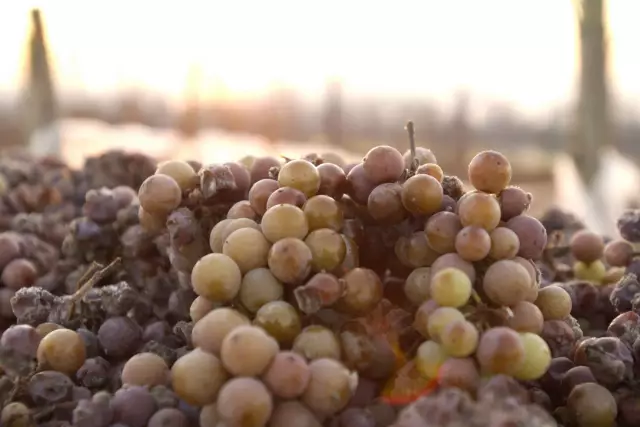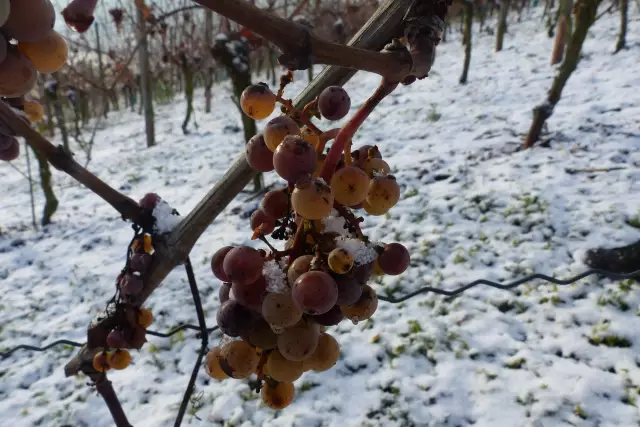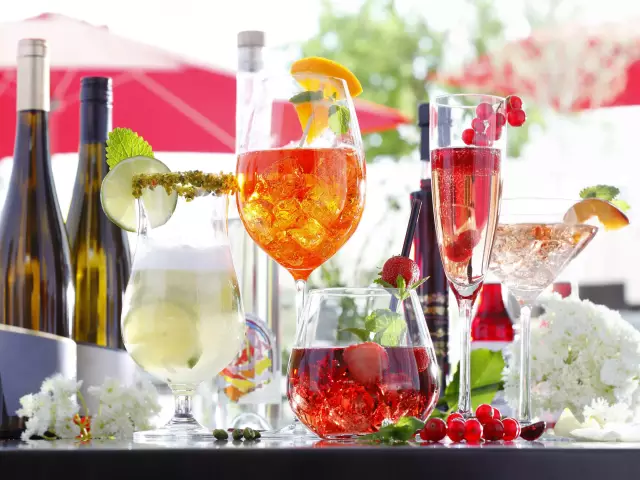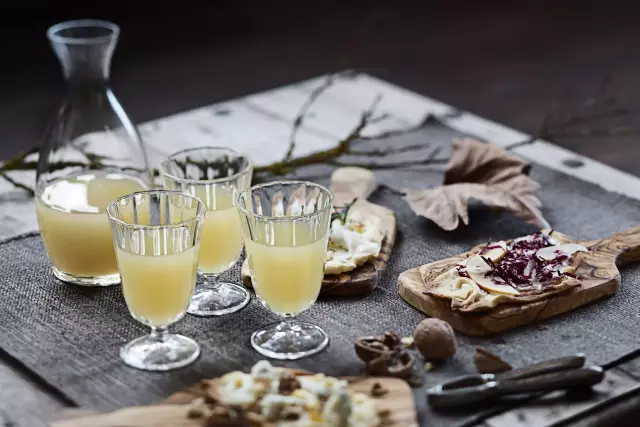Ice Wine
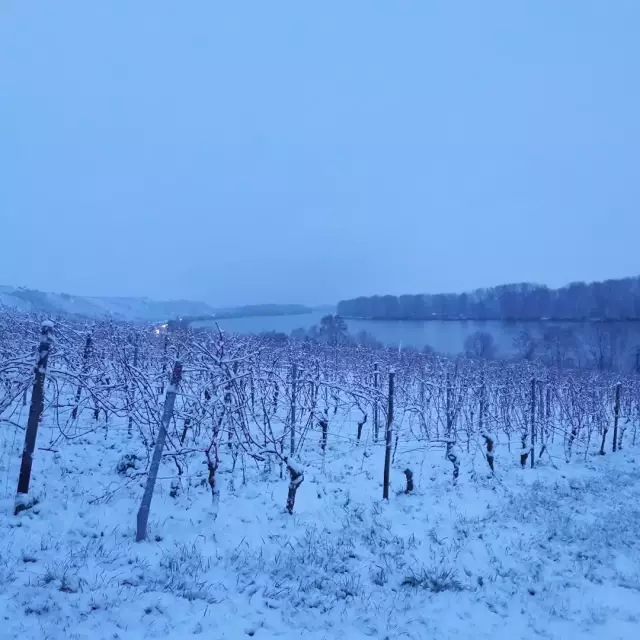
Wenn Winzer pokern, ist der Einsatz hoch. Es geht um Trauben, die länger als sonst üblich am Rebstock hängen bleiben und auf Temperaturen von mindestens -7°C warten.
Facts
-
-7°C
Grapes that hang on the vine longer than usual and wait for temperatures of at least -7°C can be used for ice wine.
-
1830
Ice wine was first documented in 1830, when winemakers in Dromersheim near Bingen in the Rhine-Hesse region accidentally discovered on February 11 that a wonderfully sweet must could be made from frozen grapes.
-
100
German ice wines usually have very high natural residual sugar contents of well over 100 grams per liter
Ice wine - a winemaker's gamble
In some years, precious rarities reward winemakers' willingness to take risks. When winemakers play such poker, the stakes are high. It's about grapes that stay on the vine longer than usual and wait for temperatures of at least -7 ° C. The winemaker's game with nature can last until January, and in rare cases until February. For the winemaker, it is all or nothing, because the ‘ice wine poker’ carries the risk of total loss.
If it doesn't get cold enough, ice wine cannot be produced. Only about 5-10% of the original harvest quantity is bottled as ice wine on average. The remaining amount of grapes is selectively cut out or falls victim to the unpredictable weather conditions.
The winemaker's masterpiece
The actual ice wine harvest, which in the vast majority of cases takes place in the early morning hours, is exhausting. The cold makes the fingers rigid and sensitive to pain. The frozen berries are laboriously harvested, and in the end the harvest quantity is often only between 300 and 500 liters per hectare. Nevertheless, the production of an ice wine is a challenge that a winery likes to face because this specialty is always seen as a masterpiece of the winemaker, which can only be produced in northern wine regions.
These requirements make things exciting not only for the winemaker but also for ice wine fans from all over the world who keep looking at the thermometer from the start of the harvest, hoping for a cold snap. The wine, which is produced as a rarity right from the start, draws collectors to the scene. High prices are asked for these noble treasures and the few available bottles are always in high demand.
The berry must freeze on the vine
It has been known since the very beginning of viticulture that minus degrees can be helpful in wine production. As early as 44 AD, the Roman writer Pliny reported on wines made from frozen grapes. In Germany, ice wine is documented for the first time in 1830, when winegrowers in Dromerheim near Bingen in Rhineland-Hesse accidentally discovered on February 11 that a wonderfully sweet must could be obtained from frozen grapes. With an amendment to the German Wine Law in 1982, "Eiswein" was raised to an independent attribute with corresponding regulations for berry selection, such as a minimum must weight of 110 to 128 ° Oechsle, depending on the growing region.
In contrast to the other noble sweet wines such as Auslesen, Beerenauslesen and Trockenbeerenauslesen, the secret of ice wine lies in the dense concentration of the berry ingredients and a comparatively high degree of acidity. This phenomenon is achieved by freezing the berries on the vine. At least -7 ° C is required before the ice wine grapes can be harvested, ideally it is -10 to -12 ° C. The naturally frozen grapes are pressed in this “icy” condition early in the winter morning. The water contained in the berries remains as ice on the wine press, while only the sweetest juice, whose freezing point is lower than that of water, is obtained as a highly concentrated must.
The yeasts have great difficulty fermenting must with such a high sugar content to wine. Therefore, German ice wines generally have a very high natural residual sugar content of well over 100 grams per liter, but in contrast to southern sweet wines, they only have a relatively low alcohol content - often only around 7% by volume.
A premium ice wine needs healthy grapes
Passionate ice wine growers pay close attention to a healthy harvest without botrytis, which is responsible for the so-called noble rot. A premium ice wine needs above all healthy grapes as a starting material and this is exactly where the taste differs from other noble sweet wines such as Beerenauslesen and Trockenbeerenauslesen. A high-quality ice wine does not have the taste characteristics of noble rot. Rather, the healthy grapes guarantee a fresh and concentrated fruity taste, and the wines generally have a relatively stable acidity. Ice wines are therefore a pleasure even at a young age.
The culmination of a culinary evening
Ice wine is a grandiose companion for festive occasions and an excellent aperitif that will delight gourmets. When the meal is completed, ice wine promises a brilliant finish: One can follow the recommendation of ‘like complements like’, especially with fruity desserts, ice cream or sorbets.
Or alternatively, follow the recommendation that ‘opposites attract’. An interesting contrast, even if it may sound unbelievable at first, is enjoying ice wine with mature fine cheese: on the one hand the salty to slightly bitter notes of the creamy cheese, on the other hand the fruity-sweet aromas of the concentrated wine, both contrasting flavors enveloping the palate and tongue, offering an exceptional taste experience.
Why and how are grapes protected that are left hanging for ice wine?
The ice wine plots are partially defoliated and wrapped in film. This process is primarily used to protect the fully ripe grapes from being eaten by birds and was first used in the 1960s. Without the film protection, no grapes would remain on the vine until December or January.
Varietals

with fresh chanterelles Autumn bruschetta
with fresh chanterelles
- 4 Ciabatta-Brötchen
- 200 Gramm kleine Pfifferlinge
- 4 EL kleingehackte Petersilie
- 4 Zehen Knoblauch
- 80 Gramm Pecorino (Hartkäse)
- 8 EL kaltgepresstes Olivenöl
- Eine Prise Salz & Pfeffer
Preheat the oven to 200 degrees.
Clean the chanterelles. Sauté the parsley in a pan with half of the oil, then add the mushrooms and cook over a low heat for approx. 5 minutes.
Slice the rolls and bake for approx. 5 minutes until crispy.
Chop the garlic into small pieces, spread on the warm bread rolls and drizzle with the other half of the oil. Coarsely grate the pecorino.
Stir the chanterelle and parsley mixture into the pecorino and spread over the halves of the rolls.
- Pinot Gris (trocken)
- Federweißer (brut nature)
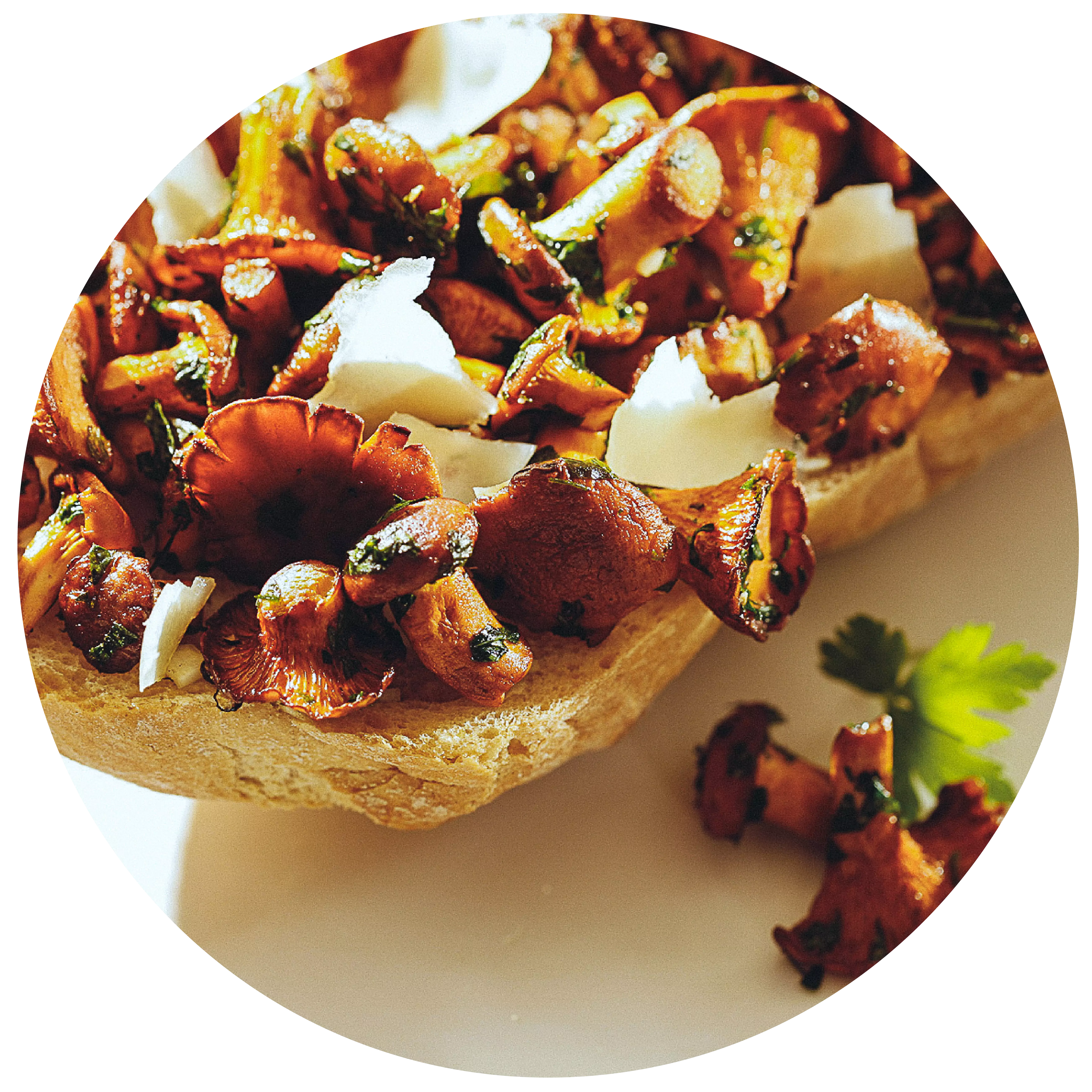
with goat's cheese Courgette and chanterelle salad
with goat's cheese
- 2 ganze Zucchini
- 3 EL Rapsöl
- 1 kleine Schalotte
- 300 Gramm Pfifferlinge
- 1 Msp. gemahlener Piment
- 2 Bund Rucola
- je 1/2 Bund Kerbel u. glatte Petersilie
- je 3 EL Walnuss- u. Rapsöl
- 4 Stück Ziegenkäse-Taler
- 1 Prise Zucker
- nach Belieben Salz & Pfeffer
Salad:
Wash the courgettes and slice thinly. Place in a bowl and mix with the oil.
Heat a grill pan and fry the courgettes in batches until golden brown. Season with salt and pepper, place in a bowl.
<p
<p>Peel and finely dice the shallot. Clean the chanterelles, wash if necessary and pat dry. Depending on size, cut in half if necessary.
<p
<p>Sauté the shallot in a pan until translucent. Add the chanterelles and fry vigorously for 3 minutes while stirring. Season with salt, pepper and allspice. Add to the courgettes. Wash the rocket and spin dry.
Dressing:
Wash the herbs, shake dry. Pluck the leaves, blend finely with both types of oil and vinegar in a blender or with a hand blender. Flavour with salt, pepper and sugar. Pour over the courgette and chanterelle mix and mix loosely with the rocket. Arrange on plates, sprinkle with goat's cheese.
- Pinot Blanc (trocken)
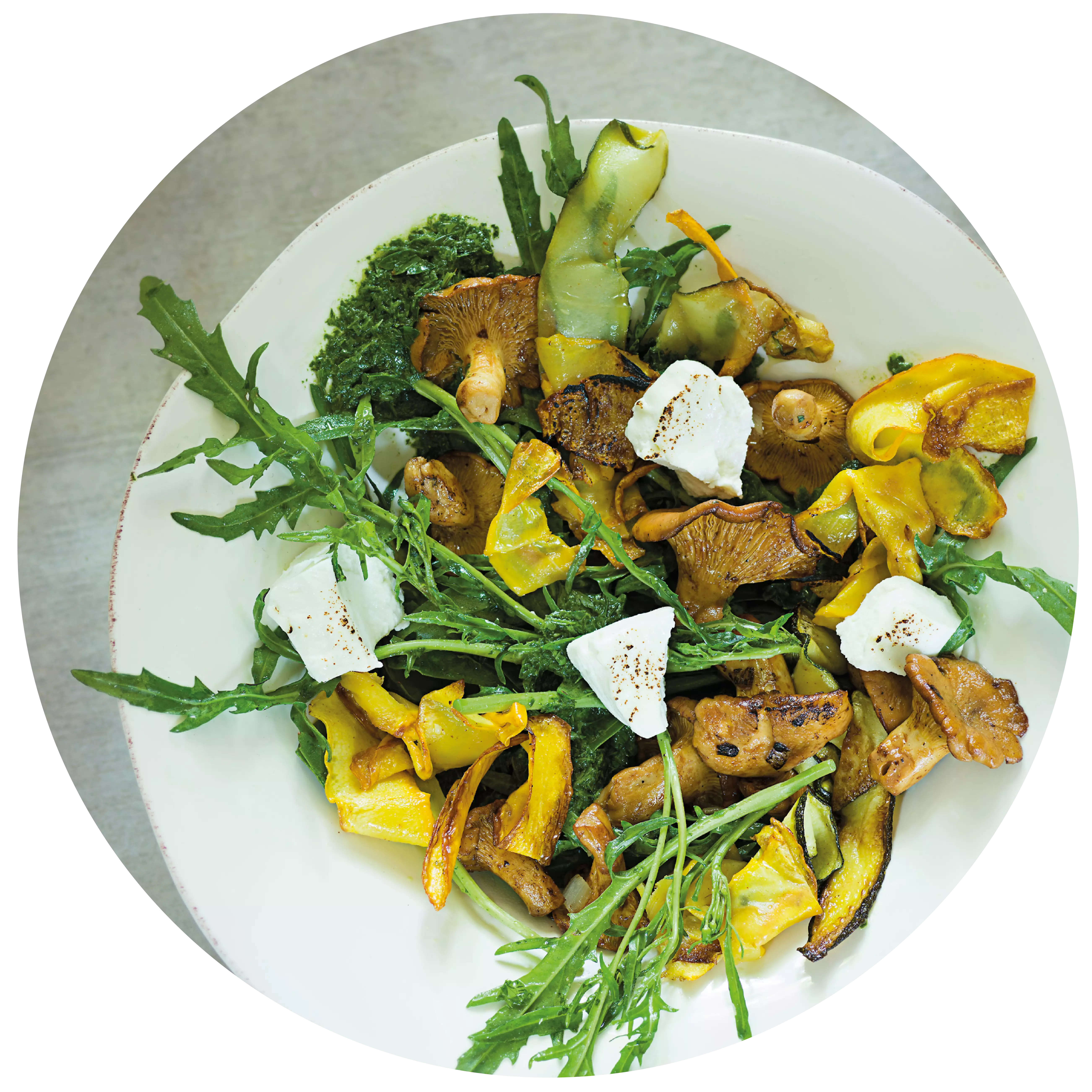
with blueberries Banana and parsley waffles
with blueberries
- 25 Gramm glatte Petersilie
- 200 ml Milch
- 2 Eier Größe L
- 70 Gramm Zucker
- 1 Päckchen Vanillezucker
- 100 ml Öl
- 75 Gramm Naturjoghurt
- nach Belieben Butterschmalz oder Pfannenfett
- 300 ml Sahne
- 1 halbe Vanilleschote
- 2,5 EL Puderzucker
- 500 Gramm Blaubeeren
- 100 ml weißer Traubensaft
- 250 Gramm Mehl
- 1 TL Backpulver
- 200 Gramm überreife Bananen
- eine Prise Meersalz
Dough:
Mix the flour, 1 pinch of salt and baking powder in a bowl and set aside.
Blend the bananas and parsley with 100 ml milk to a fine puree. Put to one side.
Separate the eggs. Mix the egg yolks with 20 g sugar, vanilla sugar, oil and banana puree until smooth. Stir in the flour mixture, milk and yoghurt with a whisk.
Beat the egg whites with 1 pinch of salt and the remaining sugar until stiff. Fold the beaten egg whites into the batter.
Topping:
Whip the cream with the seeds from the vanilla pod and 1.5 tbsp icing sugar until creamy (not too stiff!). Leave to cool.
Heat a large pan, lightly caramelise 1 tbsp of icing sugar, add the blueberries and toss briefly, deglaze with the grape juice and allow to reduce briefly.
Preheat the waffle iron and melt the clarified butter. Brush the waffle iron with a little clarified butter, ladle in the batter in batches and bake until golden brown. Serve with the topping.
- Scheurebe (süß & edelsüß)
- Silvaner (süß & edelsüß)
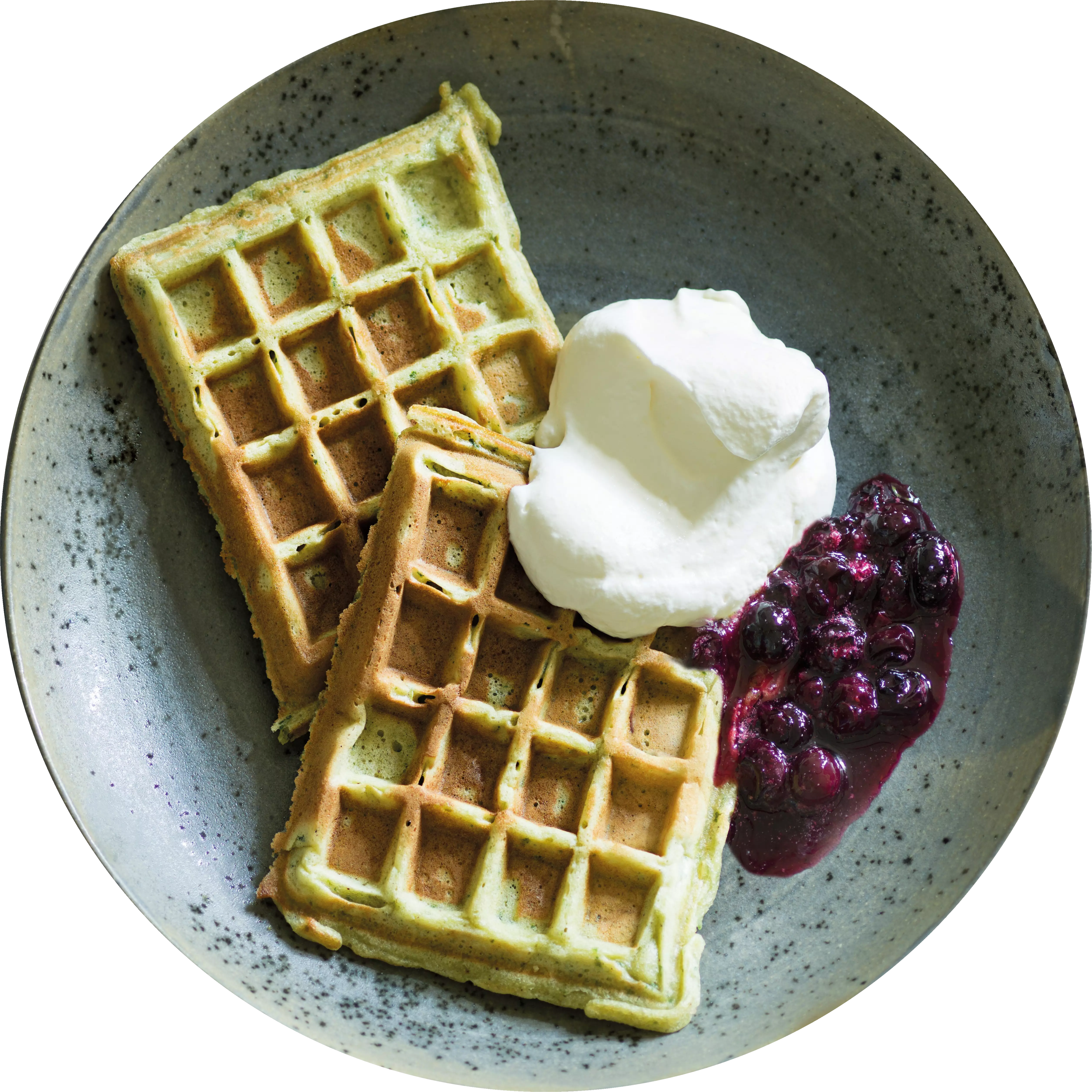
with strong red wine Wild boar ragout
with strong red wine
- 800 Gramm Fleisch vom Wildschwein (Keule o. Schulter)
- 80 Gramm Bauchspeck
- 100 Gramm Zwiebeln
- 60 Gramm Karotten
- 60 Gramm Staudensellerie
- 1 TL Tomatenmark
- 200 ml kräftigen Rotwein
- 100 ml Portwein
- 1 Liter braune Wildbrühe
- 1 TL Preiselbeeren
- 1 EL geschlagene Sahne o. Sauerrahm
- 20 Gramm Mehl
- 1 Stück Lorbeerblatt
- je 1 Zweig Rosmarin und Thymian
- 4 zerdrückte Wacholderbeeren
- 1/2 TL Senf
- nach Belieben Salz & Pfeffer
Clean and wash the vegetables and cut into evenly sized cubes.
Remove the fat, skin and tendons from the wild boar meat and cut into 3 cm cubes. Season with salt and pepper and sprinkle with flour. Heat the oil in a frying pan and brown the meat on all sides. Add the vegetables and diced bacon and fry. Add the tomato purée and stir fry. Deglaze with the red wine and port, reduce and pour in the brown game stock. Add the spices to the meat in a small spice bag and leave the ragout to simmer in the oven at 160°C for approx. 1½ hours.
Then remove the pieces of meat, remove the spices, strain the sauce, add the cranberries and mustard and leave to reduce for about 15 minutes. If necessary, thicken with a little cornflour. Serve with the whipped cream.
- Spätburgunder / Pinot Noir (trocken)
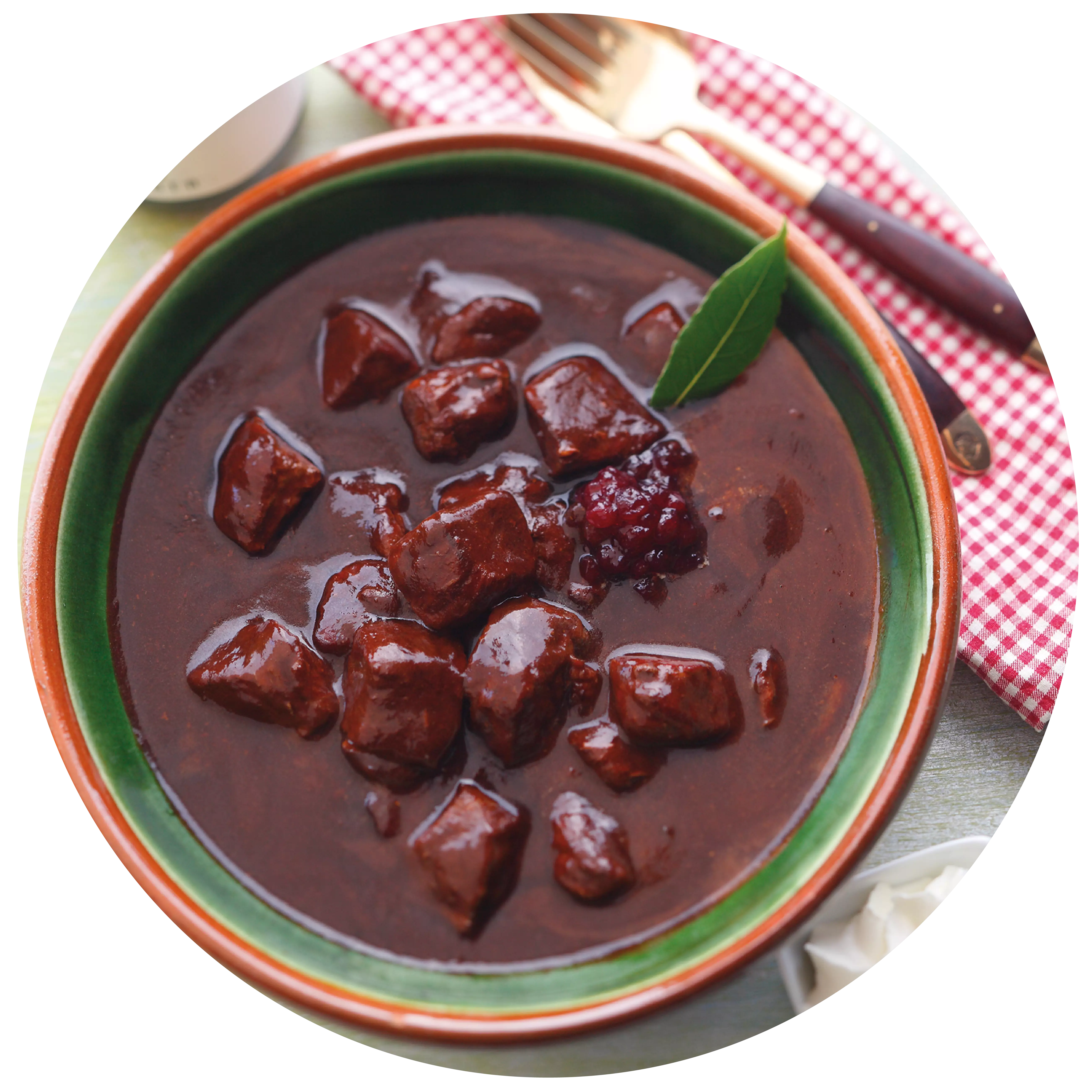
Teaser
Events
-
Show
winetasting in our winery - cheese & wine
Mainz-Hechtsheim


